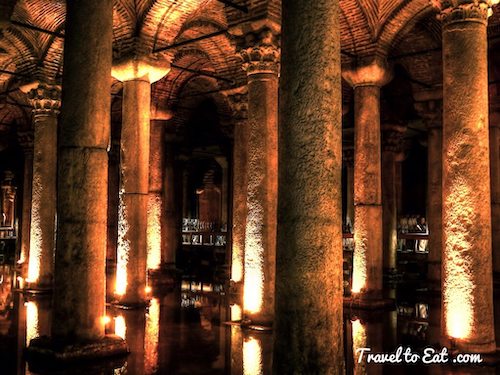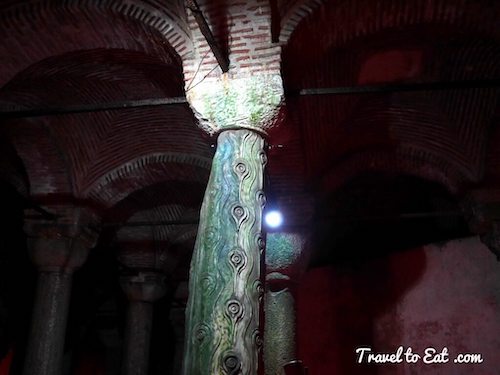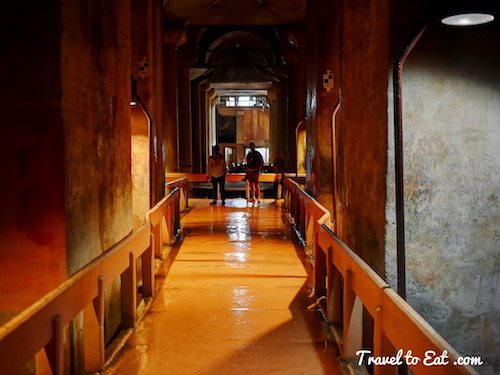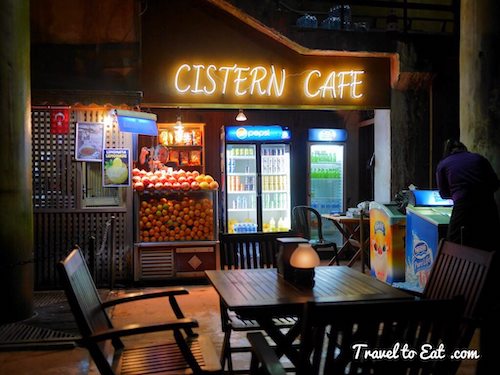
We decided to visit the Basilica Cistern (Yerebatan Sarnıcı), one of two open to the public out of hundreds of cisterns in Istanbul. Most large, important Byzantine buildings provided for storage of water beneath them. The entrance to the Basilica Cistern of Istanbul is across the street from the Haghia Sophia, opposite the yellow building of the Tourist Police in Sultanahmet. This immense underground water container was built during the reign of Emperor Justinian I in 532 to meet the water needs of the Great Palace. The name of this subterranean structure derives from a large public square on the First Hill of Constantinople, the Stoa Basilica, beneath which it was originally constructed. Before being converted to a cistern, a great Basilica stood in its place, built between the 3rd and 4th centuries during the Early Roman Age as a commercial, legal, and artistic center. The basilica was reconstructed by Illus after a fire in 476. After cleaning and restoring the Basilica Cistern, the Istanbul Metropolitan Municipality opened it to the public in 1987. After descending into the underground water facility via a flight of stairs, you can take a stroll on the concrete walkways, enjoying the subdued lighting, the mysterious and beautiful forest of columns in the semi-darkness and the cool temperatures.





The cistern was forgotten for centuries and only accidently rediscovered by the Frenchman Peter (Petrus) Gyllius in 1545. While researching Byzantine antiquities in the city, he noticed that people in the neighborhood not only got water by simply lowering buckets through holes in their basements, they miraculously sometimes even caught fish. The cistern has the capacity to store 100,000 tons of water, despite being virtually empty today with only a few feet of water lining the bottom. During the 1985 restoration, 50,000 tons of mud were removed from the cisterns, and platforms were built throughout to replace the boats once used to tour the cistern. As you can see from the pictures, the interior of the cistern is a serene, symmetrical and immense space filled with great beauty. It magically transports you back to the 6th century and resembles a cathedral more than a water cistern.



This marvelous piece of engineering only confirms yet again that the Romans (and Byzantines) were masters of civil engineering. The Basilica Cistern, which borrowed its name from the Ilius Basilica, is 143 meters long and 65 meters wide or 2.4 acres. The roof is supported by 336 marble columns, mostly in Ionic or Corinthian styles, each measuring 9 meters (30 feet) in length. These were probably brought from all parts of the empire and recycled in the construction of the cistern. Spaced at 16 foot (4.9 meter intervals), they are arranged in 12 rows of 28 columns each. Each set of four columns supported a groin vault (see my post on the arch). The cistern is surrounded by a brick wall with a thickness of 4 meters (13 ft) and coated with a waterproofing mortar. The cistern could hold 100 tons or 80,000 cubic meters of water, coming from the Eğrikapı Water Distribution Centre in the Belgrade Forest, 19 kilometers from the city through two separate aqueducts. An interesting additional element added for stability and strength are iron bars at the top of each column. They were probably added as a means to keep the columns upright while the brick groin vault domes were added. In any case, the result is an extremely stable three dimensional structure.




Historical texts claim that 7,000 slaves were involved in the construction of the cistern. One of the columns is engraved with raised pictures of a Hen's Eye, slanted braches, and tears. This column resembles the columns of the Triumphal Arch of Theodosius I from the 4th century (AD 379-395), erected in the “Forum Tauri” Square. Ancient texts suggest that the tears on the column pay tribute to the hundreds of slaves who died during the construction of the Basilica Cistern. Located in the northwest corner of the cistern, the bases of two columns reuse blocks carved with the visage of Medusa. The origin of the two heads is unknown, though it is thought that the heads were brought to the cistern after being removed from a building of the late Roman period. Some think the heads were turned to negate the power of Medussa, whose gaze turned men to stone, most scholars believe they were turned to provide the proper height for the columns they support.

I have looked for the term “Hen's Eye” in a variety of sources and mythologies and I have found nothing. Perhaps the term was taken from an ancient text describing the symbols. As a possible source of the meaning, we might consider the constellation of the Pleiades, known as the Seven Sisters to the Greeks, but also widely known as a hen with her chicks. To the Bronze Age people of Europe, such as the Celts (and probably considerably earlier), the Pleiades were associated with mourning and with funerals, since at that time in history, on the cross-quarter day between the autumn equinox and the winter solstice, which was a festival devoted to the remembrance of the dead, the cluster rose in the eastern sky as the sun's light faded in the evening. It was from this acronychal rising that the Pleiades became associated with tears and mourning. As a result of precession over the centuries, the Pleiades no longer marked the festival, but the association has nevertheless persisted, and accounts for the significance of the Pleiades astrologically.




You get around the cistern on elevated walkways which wind their way around the columns. You can have a cup of coffee in the small cafe which is a cool spot to enjoy near the exit. Elegant spotlighting makes the water shimmer with dancing lights and also you can watch the fish swimming in the shallow water. You can also throw a coin and make a wish like all locals do. They host periodic classical music concerts in the cistern, as you might imagine it has wonderful acoustics. The Basilica Cistern was featured in the 1963 James Bond movie, “To Russia with Love” and in the climax of Dan Brown's novel, “Inferno”. If you visit Istanbul, take the time to visit the Basilica Cistern.

[mappress mapid=”43″]
References:
The Basilica Cistern: http://www.istanbultrails.com/2008/06/the-basilica-cistern-the-coolest-spot-in-town/
Underground Palace: http://www.istanbulguide.com/28/places/underground-cistern.htm
Marmara Guesthouse: http://www.marmaraguesthouse.com/Local-Attractions/Details.aspx?LId=09D195BC-D4D0-4109-8C3C-35F631DC88CC
Dome: http://news.nationalgeographic.com/news/2014/02/140210-duomo-florence-brunelleschi-cathedral-architecture/
The Arch in Architecture and History: /the-arch-in-architecture-and-history/
Dan Brown: http://www.enjoy-istanbul.com/archeology/dan-brown-brings-more-visitors-to-basilica-cistern/
Pleiades: http://www.crystalinks.com/pleiades.html

